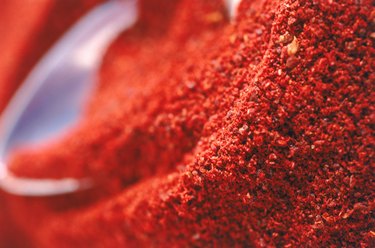
Paprika, a spice ground from bell peppers, is commonly used to add flavor and a vibrant red color to various dishes. However, some concern over paprika toxicity exists, since the spice is also added to many foods to provide red coloring and flavor in place of chemicals. You might obtain large amounts of paprika in your diet without realizing it, since it is an ingredient in ice cream, candy, baked goods, drinks, meat, soup and condiments.
FDA Policy
Video of the Day
Paprika coloring is categorized as "exempt" by the U.S. Food and Drug Administration because it is considered safe. The FDA explains that companies do not have to include paprika on their labels as a result. Instead, paprika can fall under "coloring" or "color added."
Video of the Day
Effects on Rats
In a 13-week study conducted by K. Kanki et al. at the National Institute of Health Sciences in Tokyo and published in the October 2003 issue of the journal, "Food and Chemical Toxicology," rats were given a diet containing up to 5 percent of paprika. Higher blood cholesterol levels in the rats correlated with the amount of paprika given to the rats. However, up to 5 percent paprika in the diet was considered safe and did not cause any significant health problems in the rats.
Long-Term Effects on Rats
A study by T. Inoue et al., also carried out at the National Institute of Health Sciences in Tokyo, published in the August 2008 issue of the journal "Food and Chemical Toxicology," found no toxicity related to paprika during a long-term study. The study tested various amounts of paprika in the diet of rats over a two-year period. The paprika resulted in higher levels of the formation of vacuoles, or water-filled compartments in cells, in the liver in male rats who had a diet containing 5 percent of paprika. However, there were no toxicological effects in males or females related to body or organ weight, survival rates or serum or hematological biochemical parameters. Paprika also did not cause tumors in the rats.
Considerations
Many food colorings added to make foods more appealing are associated with side effects. Because of this, paprika is a natural choice to replace red, orange and yellow food colorings, as well as to combine with other colors to create additional hues. For instance, paprika can replace Red 3 and 40 and Yellow 5 and 6, which all contain small amounts carcinogens and can cause allergic reactions, according to the Center for the Science in the Public Interest.
- Food and Chemical Toxicology -- Abstract of Article: A 13-Week Subchronic Toxicity Study of Paprika Color in F344 Rats
- Food and Chemical Toxicology -- Abstract of Article: Safety Assessment of Dietary Administered Paprika Color in Combined Chronic Toxicity and Carcinogenicity Studies Using F344 Rats
- Center for Science in the Public Interest: CSPI Says Food Dyes Pose Rainbow of Risks